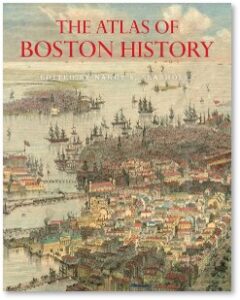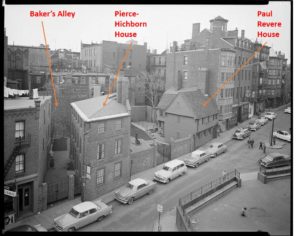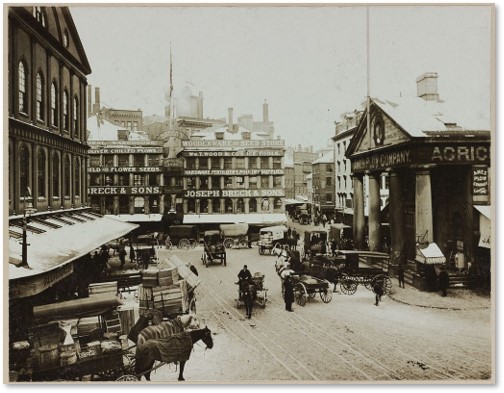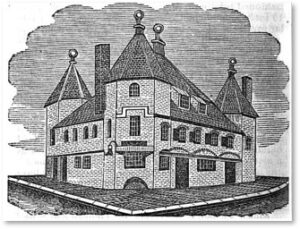In previous posts, I wrote about Boston streets named after prominent men, military battles, food and royalty. This time I want to address the early Bostonians who pursued more common occupations. These men (except for one) didn’t achieve mighty things or occupy high positions but they performed the functions that helped to keep people alive and healthy and the city strong.
Shipbuilding and Other Trades
 As Historian Nancy Seasholes says in “The Atlas of Boston History,”
As Historian Nancy Seasholes says in “The Atlas of Boston History,”
“Many industries were on or near the waterfront. They included shipbuilding, the mainstay of Boston’s trade and its most important industries, and also industries that served shipbuilders and outfitters—among them coopers, who produced the barrels and casks for exports such as fish and salt meat; ropemakers; sailmakers; carpenters; blacksmiths; caulkers; and braziers. Many retail shops of artisans, such as tailors and shoemakers, which were generally the front room of houses where goods made on the premises were sold, were along what are now Washington and Union Streets.”
Given the wide variety of essential arts, crafts, and trades in old Boston, it’s only surprising that so few streets` were named for them.
Street Names and Occupations
In alphabetical order, here are the streets named for the occupations of the people who lived on them. Many of these streets have disappeared over time or been truncated by the needs of a growing city.
Baker’s Alley
 Baker’s Alley extended from North Street just west of the Pierce-Hichborn House to the rear of the New Brick Church on Hanover Street in Boston’s North End. The church building is no longer extant, replaced by the shops and restaurants of today’s Italian North End. The North Square end of Baker’s Alley still exists but stops abruptly in the middle of the block.
Baker’s Alley extended from North Street just west of the Pierce-Hichborn House to the rear of the New Brick Church on Hanover Street in Boston’s North End. The church building is no longer extant, replaced by the shops and restaurants of today’s Italian North End. The North Square end of Baker’s Alley still exists but stops abruptly in the middle of the block.
Oddly enough, the history of Baker’s Alley makes no mention of an actual baker. Instead, Royal Governor Thomas Hutchinson had the passageway constructed so he could enter the New Brick Church by a back door. You can read more about Baker’s Alley in my post on streets named for food.
Cooper’s Alley
This street was named not for a barrel maker but for William Cooper who was ordained as a colleague to Benjamin Colman, pastor of the liberal “manifesto Church” in 1716. Cooper’s Alley was included in the extension of Washington Street that is now part of Adams Square.
Cobbler’s Court
A cobbler makes shoes and other leather goods. The land for Cobbler’s Court came from the same plot of land as School Street. Originally known as Joy’s Alley, Cobbler’s Court was created in 1722-23 as a passage ten feet, six inches wide. In 1820, it became Harvard Place. Neither of these streets currently exist.
Cook’s Court
How could all those industrious tradesmen and merchants work without three square meals to fuel their efforts? Thus, we find a Cook’s Court in Boston for a short period of time. Cook’s Court was a passageway off School Street in 1726, later known as School Street Court. In 1822 it was extended to Bosworth Street and then called Chapman Place in 1841.
The alley that runs off School Street between the rear of the Parker House Hotel and the next building appears to have been the original Cook’s Court. Suite 338 in the Parker House on the “Chapman Place corner” was occupied by Charles Dickens in 1867 – 1868. A third-floor room on that side of the hotel was also taken by John Wilkes Booth ten days before he assassinated President Abraham Lincoln.
Distil House Square
 Here we have a street with a direct connection to the occupation it was named for. Distil House Square was located near the Mill Pond, now the Bulfinch Triangle.
Here we have a street with a direct connection to the occupation it was named for. Distil House Square was located near the Mill Pond, now the Bulfinch Triangle.
Daniel Bell bought the land along with his brother-in-law, Samuel Cunnable and the men laid out a street that was a broad 20 feet wide. It bore the name of Bogg Lane (presumably for the boggy ground) and then Distil House Square for a neighborhood “given over chiefly to distilleries. In 1786 it was widened and renamed Bowker Street.
Today Bowker Street is part of a U-shaped loop that, along with Hawkins Street, runs off New Chardon Street behind the Boston Police Department.
Leather Square
Leather Square, which presumably held businesses in the leather trade, was laid out on the west side of Congress Street. Known as Sisters Lane in 1711-1712, it acquired its more prosaic name in 1867. The denizens of Cobbler’s Court probably knew the tradesmen of Leather Square quite well.
Merchant’s Row
Early Boston was, as Ms. Seasholes described, a city built on trade. Merchants made their livings buying and selling goods, so it’s not surprising that the town had a Merchant’s Row. It began in 1645 as “Mr. Hills Highway twenty feet in breadth” and took the shorter name in 1798.
Merchant’s Row held the Golden Ball tavern at its northwest corner with Corn Court. The Vernon’s Head or Admiral Vernon Tavern stood opposite on the northeast corner. Wharves stretched along the northeast side. The east side held the great warehouses and wharf belonging to the prosperous Faneuil merchant family, approximately where Chatham Street is today.
John Hancock, who built his warehouses close to his wharf, near today’s Lewis Wharf, had his store at the corner of Merchant’s Row and Corn Court. He described it as “Store No. 4 at the east end of Faneuil Hall Market.” There one of the Founding Fathers sold, “choice Newcastle Coals and Irish butter, cheap for cash.”
At the corner with the present North Market Street stood the Triangular Warehouse so named for the parcel of land on which it stood. This structure went up after the fire of 1679, which destroyed all the buildings in the vicinity of Scottow’s Dock. It was “taken down for improvements” in 1824 during what sounds like an early attempt at urban renewal.
Today Merchant’s Row runs from North Street to State Street between Faneuil Hall and Quincy Market. It’s is the only street on the north side of State Street that has clung firmly to its original position. It also still supports the buying and selling of merchandise, for which it was named.
Miller Lane
Boston boasted several mills by 1676, including ones on Copp’s Hill and by the Mill Pond. No mills were erected in the vicinity of Kilby Street, however, and Kilby Street absorbed Miller’s Lane after 1708. I have searched for Millers Lane in the 1676 Clough Map and the 1743 William Price map and can’t find it on either. Like Cooper’s Alley, it may have been named for a resident rather than an occupation.
Kilby Street today lies in the Burnt Section of Boston that was destroyed in the Great Fire of 1872. The whole area was restructured during the rebuilding, with large streets straightened and many older lanes disappearing altogether.
Thatcher Street
I would like to attribute this street to a man who made his living thatching roofs and that occupation may have played a part in it but from long before Boston occupied the Shawmut Peninsula. Instead, the city was home to many prominent members of the Thatcher family, going back to Judah Thatcher in the 17th century. Somewhere long ago in England, though, there must have been a man who covered cottage roofs with straw or reeds.
The Changing Boston Streets
Those are the Boston streets named for trades and other occupations. Hundreds of years have passed since pedestrians wended their way down those lanes or pushed their way into shops and warehouses. As cities develop and grow, their buildings rising and falling, the streets also change. Sometimes it’s just the name that shifts, while at other times the whole thing can disappear.
These days, politicians have taken to slapping their names on anything built with public funds to create memorials to themselves at public expense. I think it’s nice to know how we once honored the common man.
More Posts on Boston’s Streets
- Arch Street
- Batterymarch Street
- Bosworth Street
- Canal Street
- Causeway Street
- Derne Street
- Food and Cooking
- LaGrange Street
- Louis Prang Street
- Milk Street
- Oliver Street
- Salutation Street
- Sleeper Street
- Sun Court and Moon Street
- Temple Street
- Wigglesworth Street
- Winter Street and Summer Street
- Boston Street Names and Political Ego
- How I Started Blogging About Boston’s Streets


